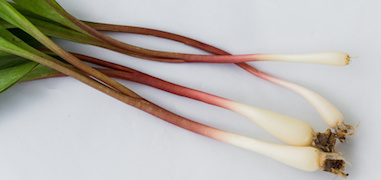
Source: My Cherokee Garden
The abundance of early spring is a delight for foragers, as they scour the forest floor, treeline canopy, lake, pond and rivers edges for wild vegetables, herbs, mushrooms, and similar delicacies.
Ramps are one of the simplest and easiest spring foods to find, as they are one of the first wild vegetables to emerge and one of the most visible and problem-free to search out, find and harvest.
Ramps aren’t typically found at grocery stores, but they are often found at farm-to-table and local eateries, or tables and boxes at farmer’s markets.
These leafy green, slightly pungent veggies are a member of the Allium tricoccum, or wild leek, family, and are similar to leeks, scallions (green onions), shallots, chives and garlic.
They provide incredible health benefits when added to spring salads or stir-fries, and are a well worth searching for in forested areas this spring and beyond.
Ramps Have a Specific Growing Range

The wild leek (ramp) growing range. Via Prairie Moon Nursery
Ramps tend to grow in areas where the soil is rich, and prefer higher elevations to lower, although they can be found in both areas. According to the website MyCherokeeGarden.com, these wild vegetables were a key food source for North American, Cherokee Indian tribes.
Ramps are found growing wild in the woods without human cultivation, and take seven years to reproduce by seed. If a population of ramps is over-harvested, they could take up to 150 years or more to regrow, as only about five percent of ramp seeds sprout after a germination period of up to two years. These healthy wild vegetables are abundant in the Eastern part of the United States with a range down to Alabama, but their range dies off out West around Oklahoma and the Dakotas, as shown by this map.
The good news is that ramps are abundant and easy to pick if you live in any of the areas shown on the map, including the Midwest, Appalachia, and parts of the American Southeast including Alabama and Mississippi.
Ramps: Also Known As ‘Spring Onions’ and ‘Wild Leeks’
Ramps are reminiscent of the previously mentioned vegetables but perhaps appear most similar to green onions in terms of taste and composition. They are more delicate and fragile than store-bought green onions, but provide similar health benefits.
Both ramp greens and lower-white ramp stalks are edible. They have more pungency than a scallion and a stronger taste than a leek.
Ramps are one of the first crops to sprout up from wild soil, but they do not last especially long in most areas.
They can be pickled, giving them a longer shelf life, and taste great in a homemade pesto, vinaigrette, or herb-infused butter. In 2023, the price of wild ramps skyrocketed to almost $35.00 per pound since they have become sought after by chefs and restaurateurs.
Try a gourmet, organic and wildcrafted body butter inspired by the wonders of the forest – Click Here
Made from organic essential oils, coconut oil, apricot oil, shea butter more –
Click here and use code ‘ALTHEALTHWORKS’ for a discount at checkout
Ramp (Wild Leek) Health Benefits: Similar to Scallions, Garlic
The allium family is famous for its healing compound allicin, which is most known as a component of garlic.
Ramps contain this compound, which helps to kill parasites, detoxify the body and flush out impurities. Ramps contain 16 calories per serving and four grams of carbs per serving according to the website FarmStarLiving.com.

Unique recipes are shared in this video:
****
Thanks for installing the Bottom of every post plugin by Corey Salzano. Contact me if you need custom WordPress plugins or website design.





